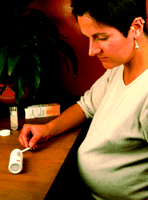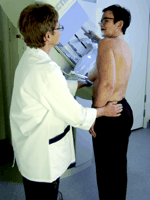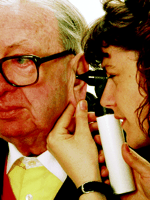This week in the BMJ
Volume 328,
Number 7445,
Issue of 17 Apr 2004
![[Down]](/icons/down.gif) Risk of complications in type 1 diabetes pregnancies remain high
Risk of complications in type 1 diabetes pregnancies remain high
![[Down]](/icons/down.gif) Be sceptical about the star system
Be sceptical about the star system
![[Down]](/icons/down.gif) Overdiagnosis of breast cancer may be higher than previously thought
Overdiagnosis of breast cancer may be higher than previously thought
![[Down]](/icons/down.gif) Adding nurse practitioners does not reduce the workload of GPs
Adding nurse practitioners does not reduce the workload of GPs
![[Down]](/icons/down.gif) Lay media marketing can burden healthcare professionals
Lay media marketing can burden healthcare professionals
Risk of complications in type 1 diabetes pregnancies remain high
Even though women with type 1 diabetes are planning their pregnancies, achieving good glycaemic control early, and taking folic acid, they are at high risk of maternal, perinatal, and neonatal complications. In a nationwide cohort study in the Netherlands, Evers and colleagues (p 915) tracked the outcomes of 323 pregnant women with type 1 diabetes and found that, relative to all pregnant women, the rates of pre-eclampsia, preterm delivery, caesarean section, maternal mortality, congenital malformations, perinatal mortality, and macrosomia were greatly increased. Neonatal morbidity, especially hypoglycaemia, occurred in 80% of pregnancies in diabetic women. The authors conclude that near optimal maternal glycaemic control (HbA1c  7.0%) does not seem to be good enough.
7.0%) does not seem to be good enough.

| |
Credit: CORDELIA MOLLOY/SPL
|
|
![[To top]](/icons/back.gif)
Be sceptical about the star system
A hospital's star rating is unrelated to its clinical outcomes. Using adult intensive care as their example, Rowan and colleagues (p 924) compared the star rating of 102 acute hospital trusts in England in 2001-2 with predicted and actual patient mortality and found that patients do just as well in hospitals with no stars as they do in those with three stars. They state that crude mortality data are misleading because higher rated trusts tend to be teaching institutions with patients who are less severely ill on admission to critical care units. The authors also say that star ratings fail to reflect the complexities of hospitals and are limited to outcome rather than process measures.
![[To top]](/icons/back.gif)
Overdiagnosis of breast cancer may be higher than previously thought
National programmes of mammographic screening can lead to one in three breast cancers being overdiagnosed. Zahl and colleagues (p 921) report that the incidence of breast cancer among women 50-69 years of age increased by 50% when Norway and Sweden introduced mammographic screening. They also found no compensating fall in incidence over age 69, when women are no longer invited for screening. In the absence of screening, the authors say, one of three women in the 50-69 age group who were diagnosed with invasive breast cancer would not have been diagnosed as having breast cancer in her lifetime. The authors conclude that women cannot make an informed choice on screening unless the level of overdiagnosis is properly explained to them.

| |
Credit: HELSINGBORGS LASARETT
|
|
![[To top]](/icons/back.gif)
Adding nurse practitioners does not reduce the workload of GPs
Nurse practitioners are used as supplements to general practice care, rather than acting as substitutes. Laurant and colleagues (p 927) randomly allocated five nurse practitioners each to four teams—comprising 30 GPs in total—and measured the level of workload before and after adding nurses. After 18 months, doctors in the intervention group, compared to the control group who did not have nurses, had increased the number of contacts with patients by 4.5 a week, especially with patients with chronic obstructive pulmonary disease or asthma. The subjective aspects of their workload, such as satisfaction, time, and cost benefits, stayed the same.

| |
Credit: HATTIE YOUNG/SPL
|
|
![[To top]](/icons/back.gif)
Lay media marketing can burden healthcare professionals
Marketing campaigns in the lay media that encourage patients to seek care may increase the workload of general practitioners and lead to prescriptions for conditions that do not necessarily require medical attention. In a retrospective cohort study of the Dutch general practice research database, 't Jong and colleagues (p 931) report that the consultation rate for new onychomycosis increased by 54% and the prescription rate of terbinafine increased by 58% in the months after the launch of a lay media marketing campaign by the manufacturer of the drug. If several lay marketing campaigns ran at the same time, they say, the impact could affect patients who need care for more serious problems.

| |
Credit: HULTON/GETTY IMAGES
|
|
![[To top]](/icons/back.gif)
Risk of complications in type 1 diabetes pregnancies remain high
Be sceptical about the star system
Overdiagnosis of breast cancer may be higher than previously thought
Adding nurse practitioners does not reduce the workload of GPs
Lay media marketing can burden healthcare professionals
 7.0%) does not seem to be good enough.
7.0%) does not seem to be good enough. 



